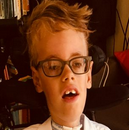At one point we thought that if Lucas had a diagnosis than the list of specialists we’d see would decrease. But in fact since he was diagnosed with muscle disease we’ve actually added more appointments to the list. In the last week we’ve had appointments with the pulmonologist, nephrologist (kidney doctor), neurosurgeon, speech and language therapist and occupational therapist. Within the next month we’ll also manage to see his pediatrician, “complex care” doctor, otolaryngologist (ear-nose-throat doctor), neuromuscular specialist, geneticist, physical therapist, a developmental doctor, and possibly the neurologists in the brain injury clinic.

Lucas's first trip around the house in the baby bjorn
The therapy sessions are the ones we actually look forward to, in part because the profession seems to attract great people, and in part because all three of us get so much out of it. In physical therapy Lucas is working on “gross motor skills”, especially building strength and control in his neck and shoulder muscles. Right now Lucas can’t hold the weight of his head against gravity for more than a few seconds when he’s on his back, which is to say that his head always falls to the side. It’s certainly not for lack of trying, but even his love of flying monkeys doesn’t help him keep his head at “midline”.
So Evan, his physical therapist, has been teaching Lucas (and us) tricks for practicing head control. Last week Lucas broke his record by holding his head midline while lying on his back for nearly 15 seconds. When we hold him up in a sitting position and hold the weight of his head for him, he’s also gaining control of side-to-side movements. These mini-steps are majorly exciting for us, since they are steps toward Lucas one day being able to hold up his head on his own, or with limited assistance. Holding up his head would make sitting up easier, which would in turn make being social in a vertical world that much easier. (But we try not to get ahead of ourselves since so much is unknown, and these future achievements lay somewhat outside all of our control.)
Lucas is also working on reaching across his body. When he’s lying on his side, he’s strong enough to make a purposeful arm movement from behind his back, over his side, and across his body to reach for a toy a few inches in front of his face. The next challenge for Lucas will be to further defy gravity by reaching his arm straight up in the air while lying on his back. It’s hard to imagine, but there are other things we had a hard time imagining a few months ago that he’s already gone on to accomplish.
As for the occupational therapist Cathy, she loves to immediately strip Lucas down so as to watch the intricacies of his body movements, especially the act of breathing. She’s seen incredible improvement in his breathing patterns, and has observed how he takes longer, deeper, more steady breaths than he did just a couple months ago. These are obviously things you can’t teach, but every time we see Cathy she has new ideas about ways we can tape or prop Lucas into positions that will help him develop better body functions. She’s also taught us to fashion a chinstrap out of athletic tape under his jaw to help pull his chin up and forward; this muscle support helps Lucas close his mouth, which is necessary in order learn to swallow.
In his sessions with Cathy Lucas also gets to roll around and practice reaching out to touch toys that beep, flash, and move in response to his touch. In a recent session Lucas clearly extended his fingers to grab at a dancing monkey. When he touched the bright purple and orange plastic, the toy played a tune, danced around, and the three of us cheered with delight, while Lucas cracked a little smile.
And then there’s the speech therapy, which is helping Lucas explore his tongue and month, and learn to swallow. We recognize it’s going to be a long process since trouble swallowing is one of the major challenges of kids with MTM. But Lucas has made some progress already through the few sessions we’ve had with the speech therapist, and meanwhile we’ve acquired some good toys and tools with which to help him explore the sensations in his mouth. A few weeks ago we used a syringe to put 1 ml of milk into Lucas’s mouth while he sucked his pacifier and admired as he gulped down a tiny bit of milk, a big step for him. He still gets all of his food through a tube, but we’ll continue to test larger quantities of milk in his mouth as he makes progress with the sucking and swallowing. Just as importantly, we hope that this therapy will continue to aid his verbalization. We are awed each time him makes sounds, however small – everyone remembers his cooing during his first whale bath, for example – and look forward to enjoying more of Lucas’s beautiful voice.
These achievements are hard to describe. When we talk to friends in short conversations, we usually say Lucas is “doing great” and tell people he’s getting stronger or doing new things. But it’s difficult to explain the grades of change, since despite it all Lucas still has incredibly low muscle tone. So even though he sometimes looks like a brilliant acrobat to us, his challenges remain huge.











